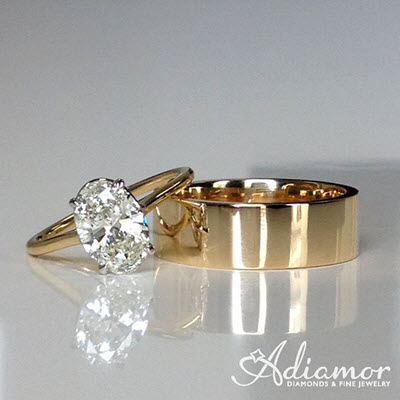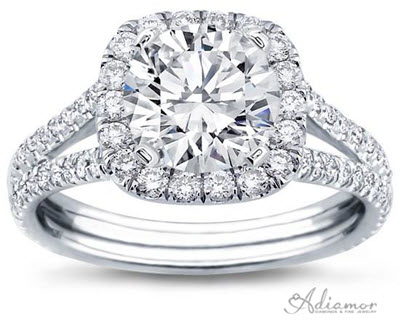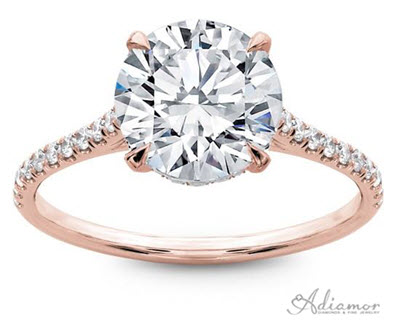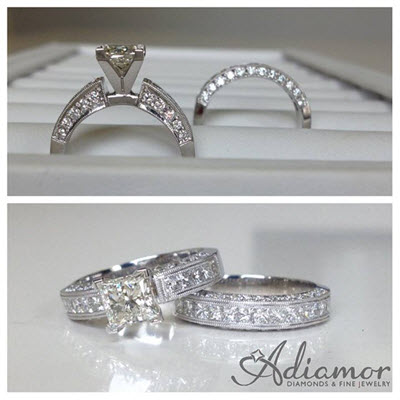Adiamor’s metal selection and extensive loose diamond supply makes it easy to create a unique, personalized piece of jewelry with any one of our many ring setting styles. In our blog, we’ve talked a lot about diamonds, but how does one choose the metal for an engagement ring? Refer to this guide to learn more about the precious metals we offer and the ideal uses for each.
The Timeless Beauty of Yellow Gold

Gold in its natural yellow form has been a part of human culture since prehistoric times, with the earliest known gold artifacts dating to the 4th millennium BCE. Keeping this in mind, it’s not at all surprising that yellow gold has been the traditional choice for engagement rings and other fine jewelry for centuries. While white gold has risen to challenge sunny yellow in the last 80 years or so, the recent surge in the popularity of yellow diamonds has returned it to the top spot once more. The warm golden hue of the metal pairs seamlessly with these gorgeous canary stones as well as traditional white diamonds.
Where Does White Gold Come From?

The average person understands that gold is yellow, and even associates the two colors as one and the same outside of conversations about jewelry. Where, then, does white gold come from?
White gold is simply a variant of yellow gold that incorporates other metals to brighten and whiten it during the alloy process. Just as other metals must be added to create 14kt and 18kt yellow gold, the same takes place when creating white gold. The metals added to make the gold harder and stronger serve a second purpose of lightening the color. The resulting metal is a very pale yellow, and after casting it into a band or setting, the piece is plated with rhodium. Rhodium is bright white and reasonably durable, allowing your white gold jewelry to maintain its brilliance for many years. The plating can wear down over time, though, so it’s good to take your ring in for regular cleaning, maintenance, and replating to keep it looking its best.
White gold achieved popularity much more recently than yellow gold, first peaking in the 1920s. Its cool tones pair wonderfully with classic white diamonds, and white gold is often used to form the prongs that secure diamonds into yellow gold jewelry to avoid distracting the eye.
Rose Gold, aka Pink Gold

The warm, peachy hue of rose gold had made it a favorite among wearers with unique tastes and as a strategic pairing with different fancy-color diamonds and precious stones.
In similar fashion to white gold, many colors of jewelry-quality gold can be produced with the addition of specific metals and different plating processes. Some of these variants lower the quality or value (for example, most green gold is 10kt), but rose gold holds comparable quality and purity to yellow or white gold with the added benefit of an exotic, striking appearance.
To create rose gold, copper is incorporated into the alloy melt instead of nickel and other white metals, and its bright, rich color infuses the gold while also strengthening it for ideal jewelry use.
What’s the Difference Between 14kt and 18kt Gold?
Gold in its pure form is a very soft metal—it measures a mere 2.5 on the Mohs hardness scale, placing it in the same range as aluminum—and, as such, is much too malleable and fragile to use in jewelry without another metal like nickel mixed in to make it strong. The karat (commonly abbreviated as kt or K) is the unit of measurement indicating how much the gold’s purity is affected by the addition of these other metals, and how many parts pure gold versus other metals remain.
Pure gold has a karat measurement of 24kt, equal to 100% purity. Using these numbers as our base, we can deduce that 18kt gold contains about 75% pure gold to 25% other metals, and that 14kt gold contains 58-59% pure gold and slightly over 40% other metals.
Both purity grades are attractive and each has its own merits: 18kt gold is purest and most valuable, and the greater density of pure gold makes it a good choice for wearers who prefer jewelry with some tangible weight to it. By contrast, gold at the 14kt purity grade is stronger, more affordable, and more lightweight, making it the better choice for pieces with delicate design elements and multiple stones to secure.
Generally speaking, observers without in-depth experience in the jewelry industry can’t tell one from the other on sight, so it’s best to base this choice on your ring’s particular features and your needs as a consumer.
Platinum, the Height of Elegance

Of the metal types suitable for use in jewelry, platinum is the most valuable. It has a noticeable weight due to its high density that immediately distinguishes it from other white metals, and develops a unique patina over time that gives older platinum jewelry a beautiful lustrous finish.
Platinum became popular in roughly the same time period in which white gold came to prominence; its cool tone and brightness were wonderfully suited to the aesthetic of the time as affluent people began to wear jewelry composed of more and larger white diamonds. Platinum’s uniqueness and rarity make it an excellent choice when you wish to truly invest in a piece of fine jewelry.
To learn more about the metals we offer or for assistance in choosing the right metal for your setting, contact Adiamor anytime!
